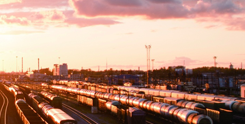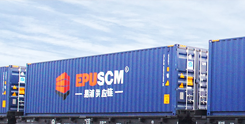A New Starting Point for the Development of Banlie in China and Europe: An Interview with Wu Yuntian, Secretary-General of the China-EU Banlie Transport Coordination Committee and Chairman of China Railway Container Transport Co., Ltd.
Publishdate:2019-01-10 Views:789

China-EU Banlie achieved the goals set in the "China-EU Banlie Construction and Development Plan 2016-2020" two years ahead of schedule. While maintaining high-speed growth, the two-way transport structure between China and Europe is becoming more and more balanced, Wu Yuntian, Secretary-General of the China-EU Ban-train Transport Coordination Committee, Chairman and General Manager of China Railway Container Transport Co., Ltd., said in an interview with China Investment.
Since its establishment on May 26, 2017, the China-EU Balancing Transport Coordination Committee has played an important role in promoting the healthy, sustained and stable development of the Balancing Transport in Central Europe by improving and strengthening the system construction and actively playing the role of coordination mechanism.
"2019 is the key year for the high-quality development of the Central European Banquet at a new starting point. To this end, the Coordination Committee will focus on organizing and promoting the high-quality development of the Central European Banquet, improving the energy efficiency of the liner transport, improving the quality of the liner transport, reducing the whole logistics cost, ensuring the safe transportation of the Central European Banquet, and strengthening the system construction." Wu Yuntian said.
Double Improvement of Quantity and Quality
Investment in China: In the past year, China and Europe have witnessed rapid development. What are the latest figures?
Wu Yuntian: In 2017, the China-Europe Banquet was organized and launched, with 318,000 TEUs of transport containers and a value of 16 billion US dollars. The number of queues exceeded the total of the first six years. From January to November 2018, the organization listed 5611 Chinese and European Banquets, an increase of 72% over the same period last year. The number of banks in the whole year is expected to reach 6000. The target set in the "China-EU Banquet Construction and Development Plan 2016-2020" is achieved two years ahead of schedule. While maintaining high-speed growth, the two-way transport structure between China and Europe is becoming more and more balanced. In 2017, 1274 return shifts were organized, reaching 53% of the total. From January to November 2018, the number of return trains has reached 71% of the number of return trains, and the number of return trains has increased significantly. While maintaining high-speed growth, the organizational scope of the Central European Banquet is also expanding day by day. At present, there are 56 cities operating in China and 49 cities in 15 European countries. The transportation of goods has gradually expanded from IT products such as mobile phones and computers to clothing, shoes and hats, automobiles and accessories, grain, wine, coffee beans, wood pulp, furniture, chemical products, medical and medical equipment, machinery and other products. While maintaining high-speed growth, member units have made increasingly rich contributions to the development of the Central European Banquet.
Investment in China: The number of return trips has reached 71% in China and Europe. What is the actual service quality and brand benefit of the return trips in China and Europe?
Wu Yuntian: The quality of class service is constantly improving. First, the level of class digitization has been further improved. In April 2018, China Railway Corporation implemented the electronic freight bills, and realized the information exchange of Sino-Russian intermodal transport bills. The management information system of international intermodal transport documents established by China Railway Container Corporation was officially put into use in July 2018. 4800 positioning chips of China-Europe liner boxes were installed before the end of the year. Second, railway boxes are more convenient to use. China Railway Container Company has set up 66 railway box return points in 16 overseas countries to provide customers with box return, box service and return box subsidy. Tielong has invested 212 40-foot and 45-foot railway refrigerated containers in China and Europe, transporting vegetables, fruits, food and electronic products to Germany, Poland, Russia and other countries, providing equipment support for cold-chain transportation. Third, railway insurance is very popular. From January to November 2018, the Railway Self-Insurance Company underwrite 2220 single cargo insurance policies for the whole journey of the Central European Banquet, an increase of 2.8 times over last year. It put in 275,000 electronic blockades and paid 12 claims, eliminating the worries of customers and further escorting the Central European Banquet. Fourth, customer service is more perfect. Every day, we hold a train teleconference, carry out two traffic information notifications, and deal with emergency situations in 24 hours, so as to ensure the safety, stability and efficiency of train transportation.
The quality of class brand is constantly highlighted. Under the joint efforts of the ministries and commissions of the national development and Reform Commission, the local governments at all levels, the China Railway Corporation and the members of the Coordinating Committee, China and Europe have become a flagship project to promote the "one belt and one road" construction, playing an important role in promoting the construction of "one belt and one road" and promoting China's comprehensive opening up. Over the past year, all sectors of society and member units have played an active role in promoting the construction of a unified brand, and have become more confident and standardized in the use and publicity of Banquet brands in Central Europe.
The development of high-quality class has achieved initial results. Over the past year, with the promotion of the National Development and Reform Commission (NDRC), the Railway Corporation (CRC) and the joint efforts of its members, the China-EU Banquet has embarked on a journey of high-quality development. All units have continuously optimized the transport organization, strengthened marketing and improved the quality of the liner transportation around the high-quality development goals of increasing the rate of heavy containers, expanding the proportion of return trips and improving the efficiency of passageways. By the end of November 2018, the number of return trips between China and Europe had reached 71%.
Organization and coordination
Investment in China: China-EU Banquet involves many countries and rules and regulations of different countries. As an important international coordinating organization of China-EU Banquet, how does China Railway Corporation conduct international communication at present?
Wu Yuntian: China Railway Corporation led the organization of seven national railways in Belarus, Germany, Kazakhstan, Mongolia, Poland and Russia to further deepen the cooperation between China and Europe. It established two working groups on transport organization and marketing, and information cooperation. It organized three working group meetings and four expert group meetings, respectively, to carry out wide-track amalgamation, plan agreement, information cooperation and the whole process. We will further promote cooperation in the areas of operational charts and capacity-building of corridors, with Lithuania, Latvia and Austria as observers, and further expand the scope of international cooperation. It has exchanged extensively with government agencies, railway companies, international organizations, associations, railway logistics, freight forwarders, ports, shipping companies, insurance, telecommunications and security service enterprises from 23 countries. Local platforms also actively carry out exchanges and cooperation with international counterparts, initially forming a multi-level, multi-form, multi-channel international coordination structure between China and Europe.
Over the past year, China Railway Corporation has actively adapted itself to the new situation and needs arising from the development of shift lines, adjusted its domestic operation plans for six consecutive times, and added 30 new train lines. By the end of 2018, the number of new train lines in China and Europe will reach 101 (including the Asian part); actively coordinated with Kazakhstan Railway, White Railway and Boeing Railway, and organized nine series of "three-in-two" transportation successively. Experts were organized to conduct port capacity survey and transport coordination at Brest, Grodno, Brusky, Sastoke, Malashevik and Shemiyanovka ports. Trials of new ports and corridors through Lithuania, Latvia, Ukraine and cross-sea transport were carried out. Trials were organized for Nuremberg-Shemiyanovka-Chengdu, Brusky-Kaliningrad-Duisburg, Lianyungang-BTS-Turkey and so on. Each member unit actively seeks solutions to alleviate port pressure, smooth train transportation and optimize transport routes. Over the past year, China and Europe have also made new breakthroughs in international parcel transportation.
2019: Improving Energy Efficiency and Reducing Costs
Investment in China: What are the objectives and specific tasks of the China-EU Banliang Coordination Committee in 2019?
Wu Yuntian: 2019 is a key year for China-EU Banlie to stand at a new starting point for high-quality development. To this end, the Coordination Committee will focus on the following five aspects of work, focusing on organizing and promoting:
Firstly, full-load transportation is encouraged to further improve the energy efficiency of liner transportation. To formulate the "Evaluation Index for High Quality Development of Classes in China and Europe", and to add new indexes such as heavy box rate and converted train, while keeping the existing statistical evaluation indexes unchanged. The current domestic policy of bundling the quantity and price by column is adjusted to that of bundling the quantity by delivery.
Secondly, we should strengthen the construction of the whole platform to further improve the quality of class transportation. We will study and establish a self-regulatory mechanism for guiding prices in the whole course of China-EU Banlie market, and promote the unified negotiations on prices and services outside China-EU Banlie market.
Third, optimize the class transportation and further reduce the whole logistics cost. To formulate the Interim Measures for Broad Rail Segment Collection and Transport Organizations in China and Europe, continue to promote the improvement of Broad Rail Segment Collection and Organization in China and Europe, make full use of the preferential prices obtained by the Collection and Merger Organizations, and further reduce the cost of the whole process of logistics. By pooling goods from all parts of the country, utilizing the preferential price of the whole railway, and organizing market-oriented public shifts, we can promote the high-quality development of the shifts between China and Europe.
Fourthly, we should strengthen security precautions to ensure safe transport between China and Europe. We will further implement the requirements of cargo loading and consolidation and safety inspection and dangerous work in China and Europe, build a safety precautionary system involving all cargo owners, agents and transport enterprises from the source of agent selection and loading, study and propose conditions for loading and consolidation adapted to full-range transport conditions, continue to improve and promote the full-range insurance services in China and Europe, further resolve the transport risks of customers, and ensure that China and Europe participate in the whole-range transport. Traffic safety of the whole shift.
Fifth, we should strengthen the system construction and further develop the advantages of the Coordination Committee. To formulate a series of management measures, establish and improve the information communication system between China and Europe, strengthen the secretariat's ability to coordinate services, and build a service platform for cooperation and exchanges among members.









